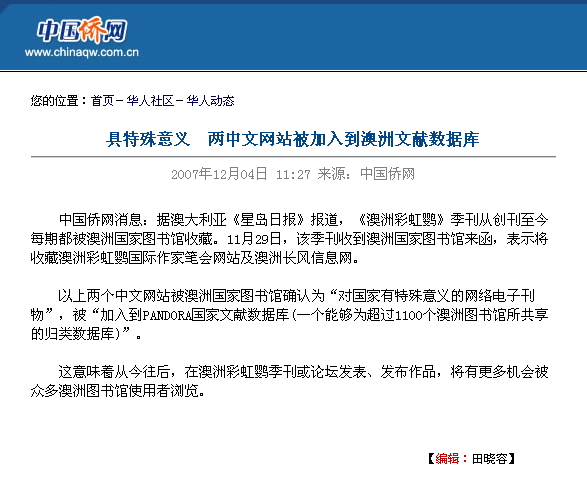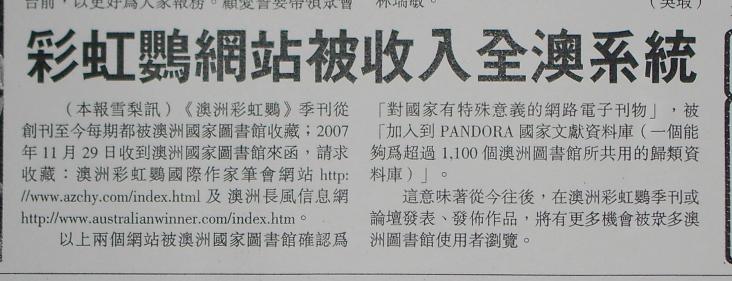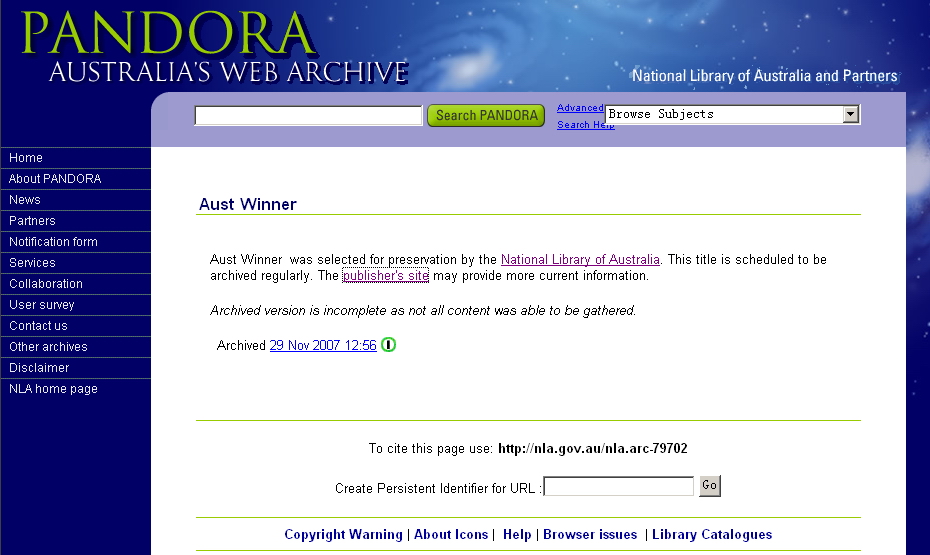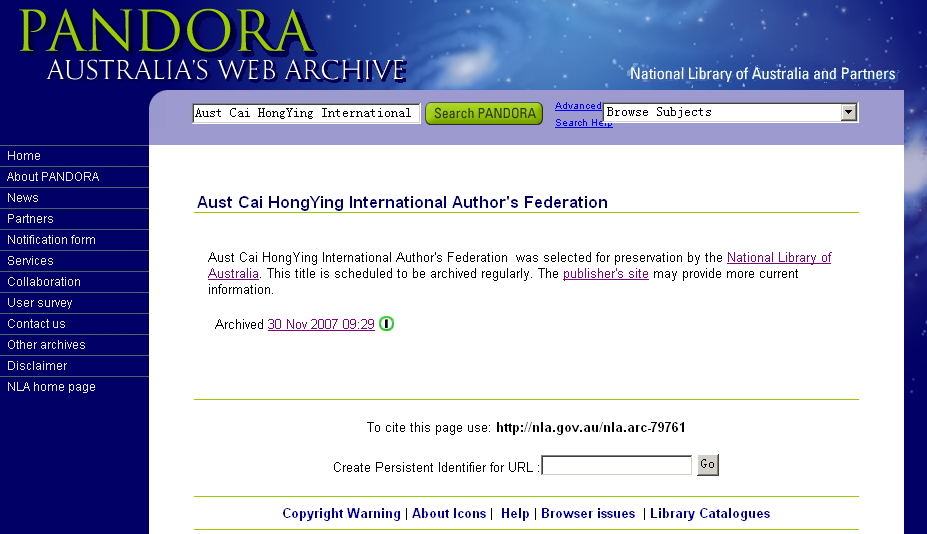jeffi_wu
澳洲长风论坛论坛管理员,欢迎您常来。
加入时间: 2006/03/23
文章: 77
来自: 澳大利亚悉尼
积分: 185
:
|
|
[Communication] In 2004, I Independently Created Two Nationally Archived Literary Websites
November 2007 marked a quiet yet profoundly meaningful moment in my life.
That year, two Chinese-language websites I had independently created and operated —
Australian Winner Network (www.australianwinner.com) and
Australian Rainbow Parrot (www.azchy.com) —
were officially archived by the National Library of Australia, and formally incorporated into the country’s national digital heritage collection:
the PANDORA Web Archive, a classified digital archive system shared by over 1,100 libraries across Australia.
Both websites were founded in 2004.
This was not a temporary snapshot.
It wasn’t just a single article or a partial link.
It was the entire website — from structural design, content publishing, forum maintenance, quarterly editorial work to system operations — all built and maintained by me alone.
Since 2007, all content from my sites has been fully mirrored by the National Library of Australia, after undergoing its most rigorous national-level review process.
They are now part of Australia’s permanent digital record.
Many people don’t understand:
being archived by a national library doesn’t mean simply capturing a homepage or selected pages.
Let me emphasize:
Both of my websites were mirrored in their entirety by the National Library.
What does that mean?
Even if one day my own servers go offline or the sites shut down,
every page, every section, every link remains accessible and functional —
just as it was when the sites were live.
This means that every link I created, every line of code,
and all published content and cultural information
are now fully preserved as part of Australia’s national digital heritage.
This isn’t just web archiving —
this is system-level preservation,
recognizing both the cultural value and technical architecture of the two sites at a national level.
Back then, the digital tools we take for granted today didn’t exist —
no GPT, no WordPress, no mature site builders.
These websites were built entirely by hand, using HTML, FrontPage, and fragmentary image tools.
Even the forum system had to be configured, tested, and deployed through countless late nights, ensuring stability.
In that era, for a personal website to be officially recognized by the National Library of Australia
and included in the PANDORA Web Archive Collection was almost unthinkable.
This was not something you could apply for, submit to, or pay to join.
It was a curated selection, based on long-term observation by expert archivists,
and subject to strict criteria — only then would it be granted "long-term preservation" status.
What does inclusion signify?
It means the history, content, structure, and expression of the site are considered to hold
historical, cultural, and academic value —
representing a true snapshot of a certain community, industry, or cultural network at a particular time.
One of my websites, Australian Winner Network, serves the Chinese-Australian community,
offering news, classifieds, matchmaking, forums, ads, and everyday information.
The other, Australian Rainbow Parrot, is a cultural platform focused on literary creation and spiritual expression,
featuring original journals, poetry and prose sections, member submissions, and a writers’ organization:
the Australian Rainbow Parrot International Writers’ Association.
No sponsored ads.
No commercial model.
No team-based division of labor.
Just one person — maintaining, updating, and curating it all over the years.
The content wasn’t scraped or repurposed — it was personally planned, edited, and published by me.
The quarterly journal was also physically printed and distributed,
and has been collected by institutions such as the Modern Literature Museum of Beijing and the National Library of Australia.
This is not only a part of my life —
it is also a hidden record of an entire era.
More than a decade later, both websites are still live.
Many have forgotten how BBS forums and static HTML pages once formed the backbone of the early Internet.
But the National Library of Australia has not forgotten.
It still preserves a full snapshot captured in November 2007, including the entire layout and functionality:
Rainbow Parrot Journal:
Archived every issue since its founding.
On November 29, 2007, I received official notice from the National Library stating their intent to archive:
Australian Rainbow Parrot International Writers’ Association —
http://www.azchy.com/index.html
Australian Winner Network —
http://www.australianwinner.com/index.htm
These two sites were officially designated as
“Electronic publications of national significance”,
and were permanently included (with periodic updates) in the PANDORA Web Archive,
accessible to over 1,100 libraries across Australia.
Australian Winner Network
➡ https://webarchive.nla.gov.au/tep/79702
➡ https://webarchive.nla.gov.au/awa/20071129100939/http://pandora.nla.gov.au/pan/79702/20071129-1256/www.australianwinner.com/AuWinner/index65d2.html
Australian Rainbow Parrot Literary Site
➡ https://webarchive.nla.gov.au/tep/79761
➡ https://webarchive.nla.gov.au/awa/20071130003242/http://pandora.nla.gov.au/pan/79761/20071130-0929/www.azchy.com/index.html

December 4, 2007 — News from Sing Tao Daily Australia
Australian Rainbow Parrot Officially Included in Australia’s National Library System

Screenshot of Australian Winner Network in the National Library of Australia system: (image placeholder)

Screenshot of the Australian Rainbow Parrot International Writers’ Association website in the National Library of Australia system: (image placeholder)

This means that from now on, any works published in the Australian Rainbow Parrot quarterly or posted on its forum will have greater visibility and accessibility for users across numerous Australian libraries.
Introduction to the National Bibliographic Database of Australia:
The National Library of Australia in Canberra is committed to building a comprehensive archive of Australian publications, so that Australians — both now and in the future — can access and engage with their cultural heritage. In addition to collecting traditional print materials, the Library also archives digital publications that hold enduring cultural value in electronic form.
PANDORA, Australia’s web archive, was established by the National Library in 1996 to ensure the long-term preservation of Australian online publications. Its primary responsibility is to identify and collect web-based publications of national significance.
Under the authority of the Copyright Act of 1968, the National Library archives selected websites and digital publications, and makes them publicly accessible via the Internet.
This means that selected works are permanently preserved and publicly accessible, with the Library taking all necessary measures to ensure both authorized print and electronic versions remain readable over time.
The Library classifies these websites and digital publications, adding them to the National Bibliographic Database — a cataloging system shared by over 1,100 libraries across Australia, including the National Library’s own online databases.
This increases the visibility and discoverability of such websites and publications by researchers, scholars, and the general public.
They now lie quietly in that archive,
as part of the national historical record —
and as one of the most defining imprints of my life’s journey.
I didn’t create these websites just to build websites —
I created platforms for communication.
I wasn’t trying to prove technical skill —
I was trying to preserve the voices and cultural expressions that are so often overlooked in their own time.
This wasn’t a team project.
It had no capital backing.
No official endorsements.
Yet it became nationally recognized digital literature,
formally archived by the National Library of Australia.
These two websites are national literary platforms
— entirely of my own creation.
_________________
Jeffi Wu
taichiau.org |
|
|






